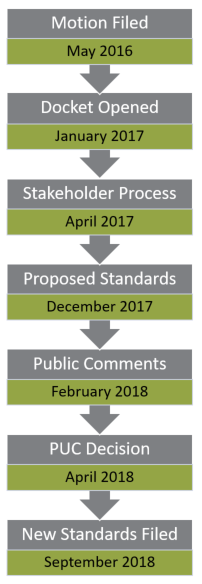When people think of energy policy, they probably think of new laws being discussed at the State Capitol. Quick decisions. High drama. Wheeling and dealing. The truth is, our energy markets are shaped by detailed rules and processes set by state agencies after extensive technical review and analysis. Over the past 18 months, Fresh Energy has been working with our partners to rewrite Minnesota’s interconnection standards, which dictate how every new distributed energy system (for example a new solar installation) connects to our distribution grid. This extensive process is a great example of the immense leg work required to reshape our electric grid and the commitment of Minnesota stakeholders to get it right.
 Setting things in motion
Setting things in motion
In May of 2016, Fresh Energy, along with our partners at Interstate Renewable Energy Council (IREC) and Environmental Law and Policy Center (ELPC), filed a motion with the Public Utilities Commission to reopen the docket governing Minnesota’s interconnection standards which had gone untouched for 12 years. In short, Minnesota had fallen behind much of the country in how we integrate distributed energy resources with the grid and this inefficiency has become a barrier to market growth in the state. The Public Utilities Commission agreed with our position, and ordered a stakeholder process be convened and tasked with hammering out updated standards using our proposal as the starting point.
Assembling the Dream Team
Over the past eight months, I’ve represented Fresh Energy as one of fifteen parties that make up the Distributed Generation Working Group convened by the Public Utilities Commission. This group includes electric utilities, energy developers, the Department of Commerce, industry groups, and policy experts. These individuals, who also have “real jobs,” committed to participation in Phase I of the process which included five full day meetings, four training webinars by national experts, a technical screens subgroup, many collaborative conversations behind the scenes, and pages and pages of reading and writing on the topic. At each step, Lead Commissioner Matt Schuerger and the hard-working Commission staff steered the group through disagreement, narrowed in on important details, and challenged us all to collaboratively contemplate the new challenges that distributed energy resource technologies present at interconnection.
What did we write?
The new and improved state process will look a lot like the Federal Energy Regulatory Commission (FERC) recommended best practice for interconnection called the Small Generator Interconnection Procedures (SGIP) which has been adopted in many states. The stakeholder group has been working to improve upon those standards in a number of ways, including by:
- Anticipating and ensuring alignment with the newest Institute of Electrical and Electronic Engineering (IEEE) 1547 standards which account for smart inverters, updated meters, and new technology
- Laying the groundwork for energy storage interconnection, both as stand-alone projects or as components of projects (e.g. solar plus storage)
- Clarifying each of the many steps along the interconnection process where the project has a “handoff” between the utility side and the customer side including clear timelines associated with each step
- Focusing on the simplification of small system interconnection to ensure a positive customer experience and remove unnecessary red tape and expense
More fun to come!
We expect a draft of the process portion of the standard to be released by the Public Utilities Commission next month, with public comments and a public hearing to follow. After a decision by the Commission this spring, the updated utility tariffs for interconnection will be officially filed in September – more than two full years after Fresh Energy’s initial motion. Meanwhile, we will begin Phase II of the Distributed Generation Working Group by filling a room with power systems engineers tasked with writing the technical requirements portion of the standard. And a few years later, as technology continues to rapidly advance, it is likely we will all meet again to ensure the standards remain relevant and complete. And again a few years after that. And then again in a few years…
The process is long and detailed, but it is important to remember that these interconnection standards govern millions of dollars in private investment across our entire state. We must reshape our energy system and that means putting in the leg work to reshape the regulation that governs it.
Huge kudos to my fellow working group colleagues. I sincerely thank you for your time, dedication, and expertise.


